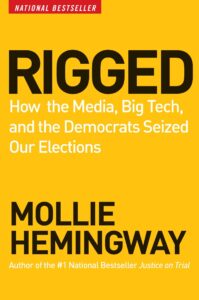
That, my friends, is a long title. But it’s an important book.
I’m going to tell you where I was on the afternoon of January 6, 2021. I was working at my desk at my “real” job when I somehow got word about people breaching the Capitol. To be honest, once I heard that news I was a little scared about what was going on because, yeah, I knew there was a Trump rally in DC that day but I figured it wasn’t going to be that big of an affair. Had the BLM/antifa crowd infiltrated that mob and gone in there to cause trouble? After reading Julie Kelly’s book, chock-full of her research and original reporting, I fear the answer may be far worse than that.
One of the most helpful aspects of January 6 is the timeline Julie puts in early on in the book. We hear a lot about snippets of what went on, particularly the unnecessary murder of an unarmed Ashli Babbitt or the suspicious death of Rosanne Boyland, but knowing the order of events is essential for gathering the big picture of what went on surrounding the nation’s capitol that fateful day.
Yet in reading the book, I found Julie’s narrative most helpful in determining why we are having the aftermath. It’s not unheard of to have a government building breached as a part of protest: just in the last decade or so we’ve had union supporters occupy the Wisconsin state house to protest legislation they believed would weaken their outsized political impact, those who opposed the nomination of Brett Kavanaugh to the Supreme Court invading the Senate office building, and out in Oregon we had incidents from each side of the political spectrum in 2016 and 2020. (Note the militia protestors took over an unoccupied building in the most rural area of the state.) Of all these protestors, the only ones who faced major charges were the militia members – the nearly 300 arrested at the Kavanaugh protest were “being processed on site and released.” Their charge: “Crowding, Obstructing, or Incommoding,” which carried a possible 90-day jail sentence and $500 fine.
In fact, this disparity between the felony charges brought forth, even to the non-violent protestors in the January 6 cases, and those faced by Kavanaugh protestors, who most likely got off with little or no punishment despite the possible sentence, is another focus of Julie’s book. (I didn’t hear about so-called comedian Amy Schumer doing hard time, did you?) Keeping in regular contact with those arrested and still holed up in a dilapidated D.C. jail awaiting trial over a year later, Kelly gives their side of the story with regard to the conditions they are being kept in as well as the abuse being heaped upon them by a legal system that’s routinely violating their Sixth Amendment rights. Remember, for most on the Capitol grounds, their actual offense could be easily construed as that same “Crowding, Obstructing, or Incommoding” which was the case with Kavanaugh, meaning they’ve served that time and then some. (Later on, in a separate article, Julie argues that there’s no way these January 6 defendants can get a fair trial without a change of venue.)
But even more worrisome to lovers of our Constitutional republic is the possibility that the Capitol protest was something of an inside job. Some people smelled a rat the night before, yelling “Fed!” when (agent provocateur?) Ray Epps repeatedly declared “we must go into the Capitol!” to anyone who would listen. But Kelly’s timeline and subsequent video research reveals that Epps and several others who were on the FBI wanted list for their involvement with the (so-called) insurrection seemed to be the ones organizing the breach of the Capitol grounds, which, unbeknownst to those attending the Trump rally, were closed for public access by an order the night before. (To give you some context, had those restrictions been in place at the 9/12 rally I attended in 2009, I and thousands of others would have been subject to arrest. And I never set foot inside.) As Kelly writes, Epps and others were taking down restricted area fencing while Trump was still speaking so those coming from the rally wouldn’t have known. Furthermore, no such restriction was in place in 2017 when Donald Trump won a controversial and protested election.
Just the implication that some faction was weaponizing the FBI is chilling enough, but Kelly goes farther by looking into the bureau’s infiltration of the Gretchen Whitmer kidnapping plot, which led to over a dozen arrests in Michigan and other states. Ironically enough, the head of the Detroit FBI field office, Steven D’Antuono, was promoted after the Whitmer arrests to become the D.C. field office head. (This is the one place in the book I noticed a glaring editing mistake, one of the few flaws in the tome.) Is it possible that the skeptics of January 5th were right in smelling a federal setup that ensnared otherwise peaceful protestors?
Kelly wasn’t looking for trouble: in fact, when 2021 began she described her plans as “to continue reporting on COVID hysteria, feckless Republican leadership in Washington, and the Biden regime’s plans to reconfigure the economy around climate change dogma. The nonstop drama surrounding Donald Trump, I figured, would take a welcome break.” Nope, not so much.
Instead, Julie’s task became that of writing an indispensible book if you want to begin to understand the drama unfolding at the Capitol that chilly winter day. (Even if you don’t, it’s still an indispensible book.) Yet the shame of deadlines and publishing is that this history is still being written insofar as the effects of January 6 were likely guiding Canadian Prime Minister Justin Trudeau’s extremist overreaction to a trucker protest as well as the potential response to a truck convoy of our own.
To call this a “war on terror against the political Right” may have been the most prescient portion of Julie Kelly’s work, because we’re seeing it come true in real time. The question is just how much we’ll put up with before the time comes when risking arrest is the least bad option.


